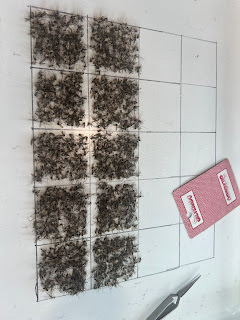Hello everyone!
Since a major part of what I am doing is identifying and counting this mosquitoes, I think it is important to go over the counting process. Within the City of Laramie, we have these cards or mats we use to sort the mosquitoes.
On these mats, you can see a list of eight mosquitoes. These are our most commonly found species. They have short descriptors that help identify them if you are less practiced. After that, it's more used for organization. In this photo below, you can see that I have used them quite a bit.
These are very useful for the larger sets of mosquitoes. I have counted up to thousands of mosquitoes in these cups that we collect. When reaching numerbers into the thousands, it can be understandably time consuming. One cup of a thousand mosquitoes can take hours to sort through. With so many cups reaching these high numbers, however, we would be unable to count these species in a realistic amount of time. There are around 20 sites that we must sort through daily. So, as we get into the thousands, there is a strategy to shorten the time used going through these groups.
This is what a large set of mosquitoes looks like when I first open the trap. From here, I can tell that these would take a significant amount of time to sort. So, I spread them into equal sets across a grid.
Here, I can see how evenly they fill each square and can make sure it is an even spread. This is essential to gathering the best data I can.
From here, I split the squares and take my time to sort one chosen square. I find the species count and use basic algebra to summarize the number of total mosquitoes based on that one square. While not as accurate as sorting through each mosquito and identifying them, it is a significant reduction in time usage and holds a decent assumption of the mosquito species ratio within the overall sample.
After these are found, I search through the entire sample of mosquitoes and count the Culex tarsalis species since we sample these separately for RAMP testing. Within the testing, we determine the severity of West Nile disease they carry. We keep the data of how many Culex tarsalis we find, when they were trapped, and where. We keep them sorted based on location and store them until they are tested.
Okay! That is my spiel on our counting process for now, thanks for reading!





That is a great idea for super high mosquito counts! I will have to ask my bosses if they have gotten over a thousand in one plate. Our traps are not very big so I wonder if we could even catch that many in one day. The other day we got a trap with around 700, but I'm sure that's been beaten in years past.
ReplyDelete